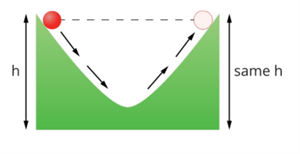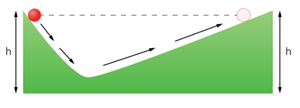
PUMPA - SMART LEARNING
எங்கள் ஆசிரியர்களுடன் 1-ஆன்-1 ஆலோசனை நேரத்தைப் பெறுங்கள். டாப்பர் ஆவதற்கு நாங்கள் பயிற்சி அளிப்போம்
Book Free DemoBy observing the motion of a marble on an inclined plane, Galileo Galilei concluded that objects constantly move when no force acts on them . He noted that when a marble rolls down on an inclined plane, its velocity increases and decreases when it climbs up. Galileo argued that, when the marble is released from the left, it would roll down and reaches the opposite side of the surface to the same height from which it was released.
Case 1:
If the planes' inclinations on both surfaces are equal, the marble will climb the same distance as it covers while rolling down.
If the planes' inclinations on both surfaces are equal, the marble will climb the same distance as it covers while rolling down.

Case 2:
When the angle of inclination of the right-side plane slowly decreased, the marble would travel farther distance until it reaches the original height.

Case 3:
When the right-side plane is made horizontal, the marble will continue to move forever, trying to reach the same height where it was released from.

Thus, by observing all three cases, Galileo concluded that the unbalanced external force must change the marble's motion, however no net force is required to keep the object in uniform motion. It is difficult to achieve zero unbalanced force in practical situations as the marble stops after travelling some distance. This is because of the presence of the frictional force, which opposes the direction of motion. Thus, by using a smooth marble, the effects of frictional force may be reduced.